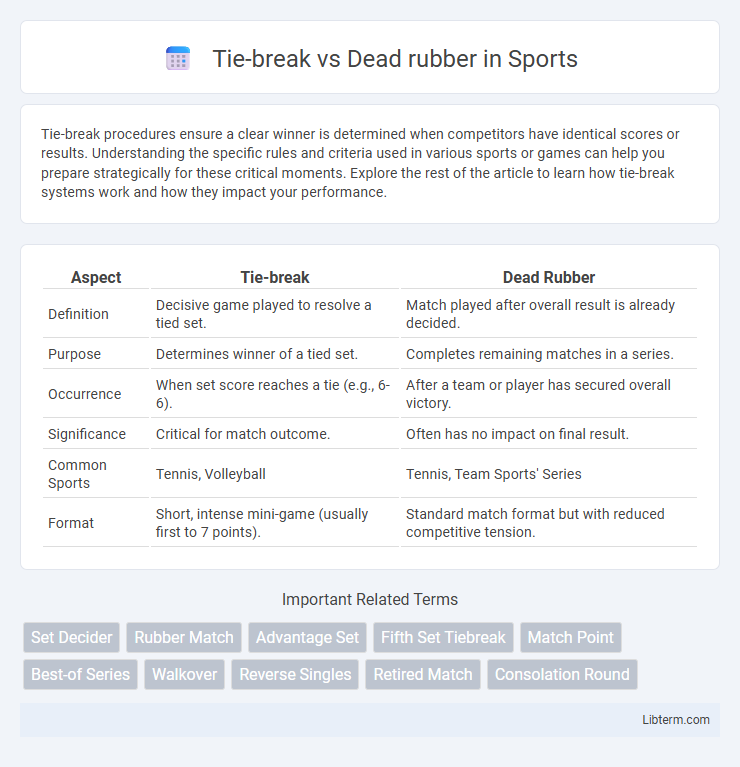Tie-break procedures ensure a clear winner is determined when competitors have identical scores or results. Understanding the specific rules and criteria used in various sports or games can help you prepare strategically for these critical moments. Explore the rest of the article to learn how tie-break systems work and how they impact your performance.
Table of Comparison
| Aspect | Tie-break | Dead Rubber |
|---|---|---|
| Definition | Decisive game played to resolve a tied set. | Match played after overall result is already decided. |
| Purpose | Determines winner of a tied set. | Completes remaining matches in a series. |
| Occurrence | When set score reaches a tie (e.g., 6-6). | After a team or player has secured overall victory. |
| Significance | Critical for match outcome. | Often has no impact on final result. |
| Common Sports | Tennis, Volleyball | Tennis, Team Sports' Series |
| Format | Short, intense mini-game (usually first to 7 points). | Standard match format but with reduced competitive tension. |
Understanding Tie-breaks: Definition and Purpose
A tie-break occurs in tennis when players reach a 6-6 score in a set, designed to quickly determine the set winner and avoid prolonged play. The purpose of a tie-break is to provide a fair and efficient method to resolve a tied set by demanding that one player must win at least seven points with a two-point margin. Unlike dead rubbers, which are matches played after the overall contest result is decided, tie-breaks directly influence the outcome of the ongoing set and match.
What is a Dead Rubber in Sports?
A dead rubber in sports refers to a match or game played when the overall outcome of a series or tournament has already been decided. This situation occurs frequently in team competitions like tennis Davis Cup or cricket Test series, where one side has secured enough wins to clinch the title. Dead rubbers often influence player selections and strategies, as they typically carry less competitive intensity and are used to give experience to less seasoned athletes.
Key Differences Between Tie-break and Dead Rubber
Tie-break is a decisive game played to determine the winner of a closely contested set, commonly used in tennis to avoid prolonged sets reaching a 6-6 score, whereas a dead rubber refers to a match in a team competition that has no impact on the overall outcome because the winning team has already been decided. Tie-breaks emphasize individual game scores and tension to clinch a set quickly, while dead rubbers often lack pressure due to their predetermined insignificance. The key distinction lies in tie-breaks affecting the winner of a set or match, whereas dead rubbers do not influence the final result of the contest.
Historical Origins of Tie-breaks in Tennis
The tie-break was introduced to professional tennis in 1970 by James Van Alen to resolve prolonged sets and reduce marathon matches, contrasting with the traditional dead rubber format where remaining matches had no impact on the overall competition outcome. This innovation aimed to maintain spectator interest and player stamina during closely contested sets that would otherwise extend indefinitely. Historically, the dead rubber occurred in team events like the Davis Cup, where the final matches did not affect the overall tie result after a winner was decided.
Psychological Impact: Tie-breaks vs Dead Rubbers
Tie-breaks intensify psychological pressure as players confront high-stakes moments where every point can alter match outcomes, demanding heightened focus and resilience. In contrast, dead rubbers often reduce competitive tension, leading to fluctuating motivation levels and potential complacency among players since results no longer affect overall tie results. This psychological distinction influences performance dynamics, with tie-breaks triggering elevated cortisol levels and dead rubbers potentially leading to decreased arousal and intensity.
Strategic Approaches to Tie-breaks
In tie-breaks, players adopt aggressive shot selection and targeted serve placements to gain immediate point advantages, exploiting the high-pressure environment. Tactical focus shifts to minimizing unforced errors while capitalizing on opponents' weaknesses, with mental resilience playing a critical role in maintaining composure. Unlike dead rubbers, tie-breaks demand precision and strategic risk-taking to secure crucial momentum for match outcomes.
Handling Dead Rubbers: Player Motivation and Tactics
Handling dead rubbers in tennis requires robust player motivation and strategic tactics to maintain competitive intensity despite the match outcome being decided. Players often adopt experimental strategies or focus on perfecting specific shots while managing energy levels to avoid injury and burnout. Coaches emphasize mental resilience and situational awareness to keep players engaged and extract valuable experience from these low-stakes scenarios.
Tie-breaks Across Different Sports
Tie-breaks vary across sports, with tennis employing a common 7-point format to decide sets tied at 6-6, ensuring rapid resolution of closely contested matches. In volleyball, tie-break sets are played to 15 points with a minimum two-point lead, providing a decisive conclusion without extending the match excessively. Unlike dead rubbers, which are dead games or matches with no impact on overall results, tie-breaks actively determine the winner in scenarios of a draw or tie.
Famous Tie-break and Dead Rubber Moments in History
Tie-break moments in tennis history include the iconic 2008 Wimbledon final where Rafael Nadal defeated Roger Federer in a thrilling fifth-set tie-break, showcasing immense pressure and skill. Famous dead rubber matches, such as the 2014 Davis Cup final between Switzerland and France, featured players like Stan Wawrinka and Richard Gasquet competing in a less decisive context but delivering memorable performances. These instances highlight the contrasting intensity and atmosphere that tie-breaks and dead rubbers bring to tennis competitions.
Future of Tie-breaks and Dead Rubbers in Competitive Sports
The future of tie-breaks and dead rubbers in competitive sports involves evolving rules to enhance spectator engagement and maintain competitive fairness. Innovations such as shortened tie-break formats and strategic utilization of dead rubbers aim to balance excitement with player endurance and tournament scheduling. Advances in technology and analytics further influence these adaptations by optimizing match duration without compromising decisive outcomes.
Tie-break Infographic

 libterm.com
libterm.com